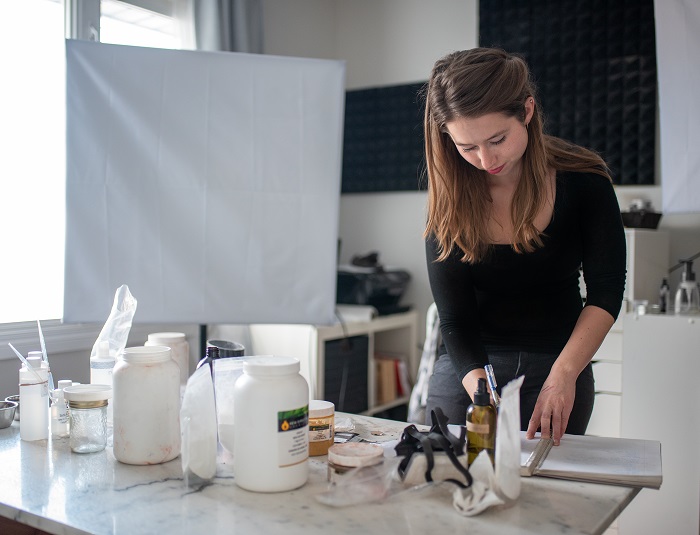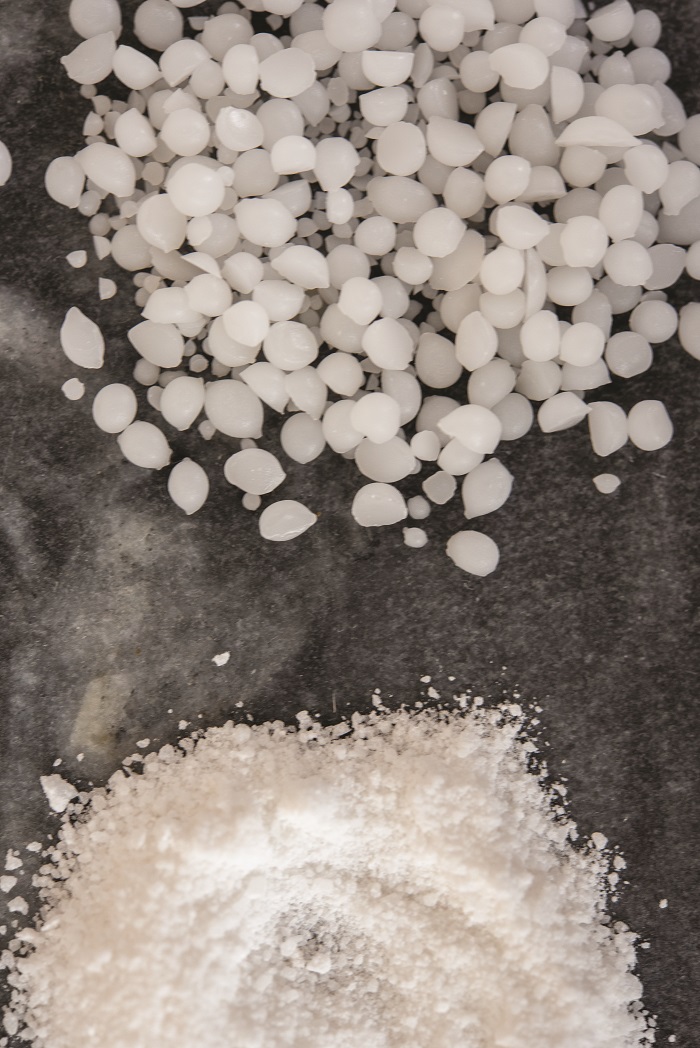Marie Rayma has been making DIY skincare and hair care products for more than a decade. Now she teaches others how to formulate their own skincare and hair care products via her blog at Humblebee and Me and her YouTube channel. She's written this post to discuss the formulation of hair conditioners.

If you’ve ever made a lotion before, you’ll be delighted to find that making creamy hair conditioners is very similar. Since conditioners are for the hair (rather than the skin) there are a few key differences, but if you can make a lotion, you can definitely make a creamy hair conditioner!
Here’s a very basic formulation guideline for creating your own creamy hair conditioner:
- 3–6% conditioning emulsifier
- 2–5% fatty thickener
- 5–25% emollients: oils, butters, and esters
- 0–10% hair care actives
- 0.5–1.5% preservative
- Water, to reach 100%
Conditioning emulsifier
This ingredient does two big jobs in a hair conditioner, and the category name is a bit of a hint. This ingredient conditions and emulsifies!
Conditioning emulsifiers differ from non-conditioning emulsifiers like Emulsifying Wax NF and Olivem1000 because of their charge: they are cationic, or positively charged (Emulsifying Wax NF and Olivem1000 are both non-ionic, aka they do not have a charge).
Our hair and skin have a negative charge, so the positively charged conditioning ingredient is attracted to our hair and skin. That’s where the long-lasting conditioning magic comes from.
You’ve undoubtedly experienced that conditioning goodness in action when you’ve used a conditioner in the shower: your hair immediately feels smooth and slippery. That's because of the positively charged ingredients in the conditioner.
Conditioning emulsifiers are also lovely in skincare, where they contribute a gorgeous powdery, silky skin feel.
Bramble Berry carries two of my all-time favorite conditioning emulsifiers:
BTMS-50 (Behentrimonium Methosulfate (and) Cetyl Alcohol (and) Butylene Glycol): This conditioning emulsifier contains approximately 50% behentrimonium methosulfate, which is the active conditioning ingredient.
BTMC (Behentrimonium Chloride): This product contains approximately 85% behentrimonium chloride (the active conditioning ingredient).
Both are fabulous conditioners, and I love them equally. I’d highly recommend trying both to see what you (and your hair) likes. You can also blend the two.
The biggest functional difference between the two is that BTMS-50 also contains cetyl alcohol, so it’ll thicken your formulations, while BTMC won’t. This difference isn’t good or bad, it’s just something to keep in mind as you work.
Now, these ingredients do smell a bit fishy, especially if you’re sniffing them straight out of the bag. This scent doesn’t usually come through in finished products, especially if you’re using less than 10%, but you might notice it if you’ve got a sensitive nose. I recommend including a fragrance in your hair conditioners to cover up any fishy whiffs.

Fatty thickener
A fatty thickener will powerfully boost the viscosity of your conditioner as well as boost richness. As little as 0.5% can make a big difference to a formulation.
If you’ve used BTMS-50 a fatty thickener is a nice-to-have, but if you’ve used BTMC I’d say a fatty thickener is essential. Each one offers different benefits, so choose your thickener based on your formulation goals, and feel free to blend them!
- Cety alcohol: Slippy, silky, great luxurious skin feel.
- Stearyl alcohol: Creamy, rich.
- Cetearyl alcohol: A blend of cetyl and stearyl; slippy, rich yet silky, creamy. A good middle/average option, and very popular in haircare!
- Stearic acid: Rich, buttery, can be stiffening depending on concentration.
Emollients: Oils, butters, and esters
There are so many wonderful options to experiment with in this category!
The oils, butters, and esters in your conditioner are where the bulk of the richness of the conditioner comes from. The larger your oil phase is, the richer your conditioner will be, so think about how heavy you want your conditioner to be when deciding which oils—and how much—to use. 10% will be fairly light, and upwards of 20% starts to get quite rich.
The richness of a conditioner is really important to what type of conditioner it is: a leave-in conditioner will typically be lighter (and therefore have a smaller oil phase), while a rinse-out conditioner will be richer. A treatment-type hair mask will be even richer. You’ll also want to think about the type of hair you’re formulating for: is it easily weighed down, or does it need a serious dose of moisture? Let what you’re making, and the hair you’re making it for, guide your formulation decisions.
I recommend choosing liquids as the bulk of your emollients. This can be liquid oils like safflower oil, marula oil, and argan oil. Different oils have varying ability to coat the hair (improving shine) and absorb into the hair (improving flexibility). I highly recommend this post from the Science-y Hair Blog to learn more.
To create lighter products and boost slip, you can also include lightweight liquid esters like Ethylhexyl olivate and Plantasens Olive LD. These ingredients are often marketed as natural alternatives to silicone, and can be great choices when formulating for hair that is easily weighed down.
Butters can also be beautiful in hair conditioners, adding richness and viscosity (as well as undeniable label appeal!). I recommend keeping butters to less than half of your oil phase as really butter-heavy emulsions don’t feel as nice as emulsions made with a blend of oils and butters. This is just a recommendation, though—feel free to try it and see what you think!

Hair care actives
There are so many wonderful ingredients in this category!
- Panthenol: Also known as vitamin B5, panthenol helps moisturize the hair and boost shine and bounce. I include this fabulous ingredient in most of my formulations; 0.5–1% is a good place to start for haircare creations.
- GuarCat: This is a modified guar gum that is cationic, combining the thickening properties of guar gum with conditioning goodness. I love including 0.1–0.5% cationic guar gum in conditioners to boost viscosity and conditioning properties.
- AC Rice Curl Complex: This new-to-Bramble Berry ingredient is formulated specifically for curls, helping strengthen and protect curls and waves while improving retention.
- Hydrolyzed proteins: Hydrolyzed proteins help strengthen and moisturize the hair. There are lots of great hydrolyzed proteins to choose from, including quinoa, silk, keratin, and wheat. Be sure to research the specific protein you want to use to learn more about their unique benefits, and feel free to blend them in a formulation.
- Botanical extracts: Oil and water soluble botanical extracts can offer haircare benefits and label appeal. Bramble Berry carries a wide variety to choose from.
Check out even more wonderful hair care actives from Bramble Berry by clicking here.
Preservatives
As this is an emulsion, a preservative is required to keep the product safe and stable. I recommend Optiphen Plus or Liquid Germall™ Plus. Both are easy to use and effective. Optiphen Plus can be incorporated once the product is below 80°C (176°F), while Liquid Germall™ Plus should be added once the emulsion is below 50°C (122°F).
The importance of pH
For optimal hair health, the pH of a hair conditioner should be mildly acidic: aim for 4–6.
Colour & fragrance
If you’d like to color your conditioner, a 0.5–1% of a mica will do the trick. I recommend including it in your cool down phase.
Fragrance oils and essential oils can be used to scent hair conditioners. I typically use around 0.1% for a light scent, and will go up to 1% if I really want the scent of the conditioner to linger in the hair. Include fragrance & essential oils in the cool down phase of your formulation.
Be sure to use Bramble Berry’s fragrance calculator to ensure you’re using your fragrance & essential oils safely.

Water & other watery things
Distilled water is our “quantity sufficient” ingredient; the ingredient we use to bring the formulation up to 100% after deciding on all the other ingredients. Water dilutes the other ingredients, improves spreadability, and delivers hydration.
If you want to get a bit fancy you could definitely swap some of the distilled water for a hydrosol or distillate to add a bit of scent!

